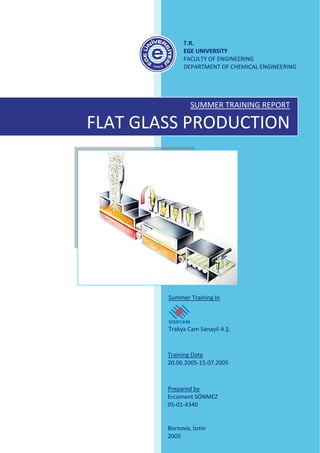
Training Report - Trakya Cam San.
- 1. T.R. EGE UNIVERSITY FACULTY OF ENGINEERING DEPARTMENT OF CHEMICAL ENGINEERING SUMMER TRAINING REPORT FLAT GLASS PRODUCTION Summer Training In Trakya Cam Sanayii A.Ş. Training Date 20.06.2005‐15.07.2005 Prepared by Ercüment SÖNMEZ 05‐01‐4340 Bornova, İzmir 2005
- 2. Ö Z E T Bu rapor, Trakya Cam Sanayii A.Ş. Trakya Fabrikası’ndaki stajım boyunca düz cam üretim teknikleri, çeşitleri ve üretime yardımcı prosesler konuları hakkında edindiğim bilgileri içermektedir. Cam, çeşitli oksitlerin ergitilmesi ve kristalleşmesine izin verilmeden oda sıcaklığına kadar soğutulmasıyla oluşan parlak yüzeyli, şeffaf bir inorganik üründür. Viskozitesi oldukça yüksek bir madde olan cam, normal koşularda sıvı halde olmasına rağmen katı madde özellikleri gösterir. Trakya Cam Sanayii A.Ş. Trakya Fabrikası’nda üretilen düzcamın kompozisyonunda kum, dolomit, soda, kireçtaşı, sülfat ve feldspat bulunur. Cam üretiminin aşamalarının ilki ve en önemlilerinden biri harmanın hazırlanmasıdır. Harman, camı oluşturacak hammaddelerin belirlenmiş oranlarda tartılması, karıştırılması ve fırına kadar kayıpsız olarak aktarılmasıdır. Oluşan herhangi bir sorun nedeniyle istenen kriterlere sahip olmayan harman yani bozuk harman fırına verilmez, bozuk harman bunkerine atılır. Harmandan gelen karışım, iç sıcaklığı maksimum 1580°C olan fırında ergitilir. Bu işlem sırasında açığa çıkan gazlar camın yüzeyine nüfuz ederler. Takip eden aşamada, camın kalitesinin düşmemesi için bu gazlar afinasyon adı verilen işlemlerle camdan uzaklaştırılırlar. Afine edilmiş cam, fırının boyun kısmında homojenize edilerek dinlendirme havuzuna aktarılır. Dinlendirme havuzunda şekillendirmeye uygun hale gelen cam, yaklaşık 1100°C sıcaklıkta iken kalay banyosuna alınır. Burada cam, toproll makinesi ve daha sonra lift‐out ruloları yardımıyla istenen kalınlığa ulaştırılır. Kalay banyosu sonunda sıcaklığı 600°C’ye düşürülen ve şerit haline getirilen cam, tavlama tüneline aktarılır. Bu bölümde, cam şeridinde gerekli sıcaklık farklılıkları oluşturularak, cam kesime uygun hale getirilir ve tavlama tünelinden yaklaşık 50°C sıcaklıkta çıkar. Düzcam üretiminin son aşaması olan kesme kısmında cam, müşterilerin taleplerinde belirtilen boyutlarda kesilir, kalite kontrol laboratuarında kalitesi belirlenir ve kalitesine göre paketlenir. Training Report – Şişecam/Trakya Cam Sanayii A.Ş. I
- 3. A B S T R A C T This report contains all my experimentation about float glass production techniques, varies and utilities to the production processes during my summer training in Trakya Cam Sanayii A.Ş. Trakya Factory. Glass is a transparent inorganic product with bright surface, which is produced by smelting of various oxides and the solidifying by cooling to room temperature without crystallization occurrence. Glass, which viscosity is very high, despite of being a liquid phase material, shows the properties of a solid. There is sand, dolomite, soda, limestone, sulfate and feldspar in the composition of the float glass produced in Trakya Cam Sanayii A.Ş. Trakya Factory. Batch preparation is the first and one of the most important steps of glass production. In this process, the raw materials are weighed in the predetermined ratios, mixed and transferred to the furnace without any loses. Corrupt batch that does not have the desired criteria as a result of any problem is not allowed into the furnace but taken to the corrupt batch bunker. Mixture coming from the batch section is smelted in the furnace of which inside temperature is maximum 1580°C. The gases revealed during this process enter the structure of the glass. These are removed by affination process in the next step so as no to reduce the quality of the product. The affinated glass is homogenized along the neck of the furnace and transferred to the resting pool. The glass, made suitable for shaping in the resting pool, is taken into the tin bath at the temperature about 1100°C where it is brought to the desired thickness with the help of top rolls and lift‐out rolls. The temperature of the glass is decreased to 600°C; it is made into ribbon shape at the end of the tin bath and transmitted to the annealing lehr. In this section, required temperature differences on the glass are maintained and the glass is prepared for cutting. The temperature of the glass at the exit is about 50°C. In the cutting section, which is the final step in float glass production, the glass is cut in the dimensions demanded by the customers, classified according to its quality in the quality control laboratory and packed with respect to its quality. Training Report – Şişecam/Trakya Cam Sanayii A.Ş. II
- 4. TABLE OF CONTENTS ÖZET I ABSTRACT II TRAINING PROGRAM in the FACTORY III 1.0‐ INTRODUCTION 1 1.1‐ Introduction to ŞİŞECAM 1 1.2‐ Introduction to Trakya Cam Sanayii 2 2.0‐ HISTORY of FLOAT GLASS 6 3.0‐ INTRODUCTION to FLOAT GLASS 8 4.0‐ MANUFACTURING PROCESS of FLOAT GLASS 10 4.1‐ Raw Materials 10 4.1.1‐ Sand 10 4.1.2‐ Soda 10 4.1.3‐ Dolomite 11 4.1.4‐ Limestone 12 4.1.5‐ Feldspar 12 4.1.6‐ Sodium Sulphate 13 4.1.7‐ Coloring Agents 13 4.2‐ Batch Preparation 14 4.3‐ Mixing 16 4.4‐ Melting and Refining 18 4.5‐ Floating (Sn Bathing) 23 4.6‐ Annealing 27 4.7‐ Finishing Operations 28 4.7.1‐ Cold End 28 4.7.2‐ Cutting 28 4.7.3‐ Conveying 29 4.7.4‐ Flexibity with Robots 29 4.7.5‐ Stacking 30 4.7.6‐ Packaging 30 4.7.7‐ Control 30 Training Report – Şişecam/Trakya Cam Sanayii A.Ş.
- 5. 5.0‐ QUALITY CONTROL 32 6.0‐ TRAKYA RESEARCH LABORATORY (Trakya XRF) 34 7.0‐ PLANT AUXILARIES 35 7.1‐ Description of the Utility Foundation Chieftaincy Department 35 7.1.1‐ Natural Gas 35 7.1.2‐ Hydrogen 36 7.1.3‐ Nitrogen and Instrument Air (Pressurizes Air) 36 7.1.4‐ Technologic Water 37 7.1.5‐ Crude Water 37 7.1.6‐ Drinking Water 38 7.1.7‐ Boiler 38 7.1.8‐ Fire System 38 7.1.9‐ Purifying Systems 38 7.1.10‐ Fuel‐Oil Systems 38 7.1.11‐ Duty Homes 38 8.0‐ HEALTHY‐SAFETY‐ENVIRONMENT 39 9.0‐ RESEARCH and DEVELOPMENT 40 9.1‐ Is glass solid or liquid? 40 9.2‐ H2 and N2 Production 45 9.2.1‐ H2 Production 45 9.2.2‐ N2 Production 54 10.0‐ ENGINEERING APPROACH to the PROCESS 56 10.1‐ Heat Transfer in Glass Melting 56 10.2‐ Problem about LHV of Natural Gas 58 10.3‐ Basically Energy Balance around the Furnace 61 10.4‐ Problem about Steam Generator (Boiler) 63 CONCLUSION 67 REFERENCES 68 APPENDICES 69 Training Report – Şişecam/Trakya Cam Sanayii A.Ş.